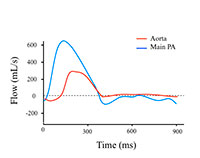| Sample Questions
Question #1
To increase the T2 weighting in a spin echo STIR sequence:
- a) TE is decreased and the flip angle is increased.
- b) TE is decreased and TR is increased.
- c) TE is unchanged and central k-space is acquired first.
- d) TE is increased and TR is unchanged.
- e) TE is increased and TR is decreased.
> Click here for the correct answer
Question #2
Regarding multi-modality imaging of the pericardium, which is the most appropriate statement?:
- a) Chest X-ray is the best technique to detect pericardial calcification
- b) Echocardiogram is considered the first line option
- c) CT reliably discriminates the pericardial effusion from increased pericardial
thickness
- d) CMR provides the most comprehensive information on intra-cardiac flows
- e) SPECT and PET may be useful in the evaluation of pericardial effusion
> Click here for the correct answer
Question #3
Which of the following statements is most true regarding myocardial oedema
imaging with CMR?
- a) Myocardial oedema is commonly assessed with steady-state free-precession cines
- b) Areas of regional myocardial oedema have a low signal on T2-weighted sequences
- c) Oedematous myocardial regions are usually confined to the subendocardium
- d) White and black-blood T2-weighted CMR sequences can be used for oedema imaging
- e) The area of oedema is usually smaller than the area of infarction.
> Click here for the correct answer
|
|
Question #4
Retrograde flow in the left vertebral artery by phase-contrast imaging usually indicates significant stenosis in the:
- a) Brachiocephalic artery
- b) Left common carotid artery
- c) Distal left vertebral artery
- d) Proximal left subclavian artery
- e) Basilar artery
> Click here for the correct answer
Question #5
53 year-old female is referred for CMR after echocardiography has suspected hypertrophic cardiomyopathy. Which is the single best answer? In hypertrophic
cardiomyopathy
- a) the obstructive form often results in mitral stenosis
- b) the systolic anterior motion of the mitral valve (SAM) can only reliably be detected by echocardiography
- c) late gadolinium enhancement is often present in the right ventricular wall
- d) outflow tract obstruction results in a bright jet on steady state free precession cine images
- e) left ventricular apical aneurysms can be present
> Click here for the correct answer
Question #6
The following image shows flow curves from the main pulmonary artery and aorta in a 2 year-old female with signs of cardiac failure and a dilated left ventricle.
The lesion is

Flow curves from main pulmonary artery (PA) and aorta
- a) Patent ductus arteriosus
- b) Ventricular septal defect
- c) Atrial septal defect
- d) Anomalous pulmonary venous drainage
- e) Aortic valve disease
> Click here for the correct answer
|
